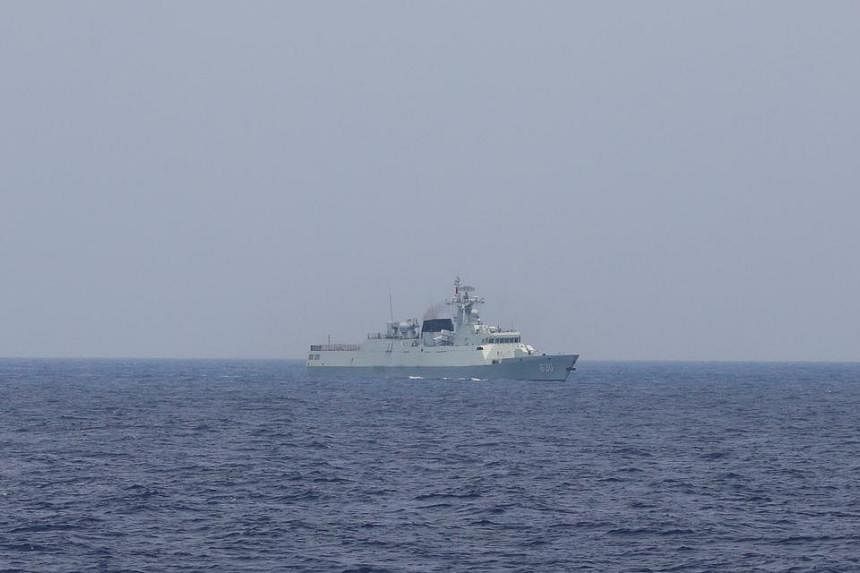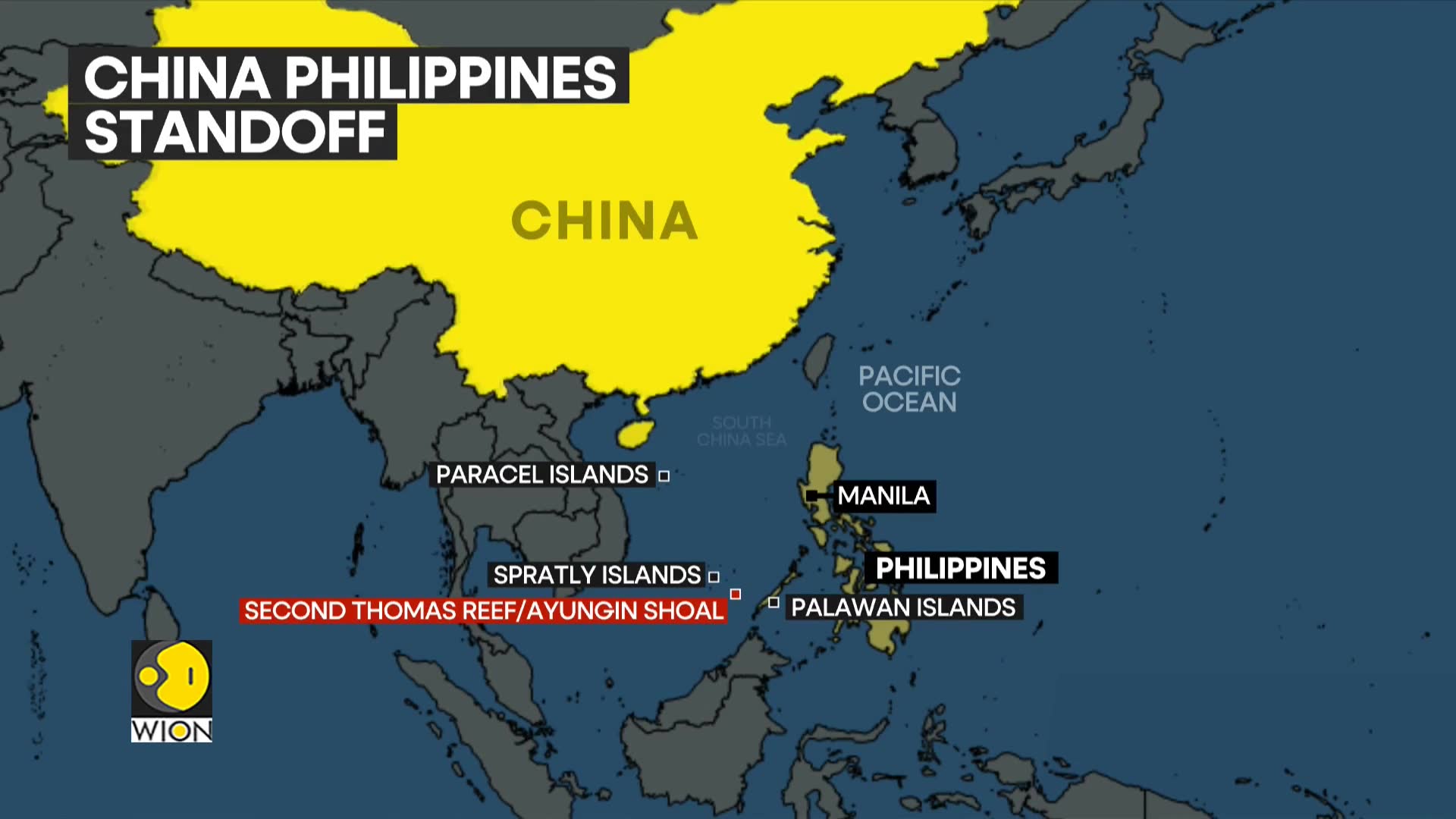WWIII
Report: Illegally grounded vessel of Philippines destroys ecosystem
A Chinese scientific expedition team discovered that the illegally grounded Philippine military vessel near China's Ren'ai Reef in the South China Sea has rusted, with peeling paint and the leaching of heavy metals severely affecting the quality of surrounding waters, according to a report.
The "Report of the Illegally Grounded Military Vessel Destroying the Coral Reef Ecosystem at Ren'ai Reef", released on Monday by the Ministry of Natural Resources' South China Sea Ecological Center and the South China Sea Development Research Institute, said that personnel on the vessel are suspected of fishing, and fishing nets and garbage have led to extensive coral death.
The Philippine military vessel has been illegally grounded since 1999 near Ren'ai Reef, an uninhabited reef that is an integral part of China's Nansha Islands in the South China Sea. This not only seriously violates China's sovereignty but also causes continuous damage to the coral reef ecosystem, according to the report.
Xiong Xiaofei, chief scientist of the scientific expedition, said: "When I saw large areas of dead coral and fragmented coral reef pieces, I felt deeply saddened. Philippine fishing nets are entangled in the coral, and there is a large amount of garbage scattered around." The Philippine military vessel was run aground in the northern part of Ren'ai Reef, he added.
In April, a team of scientists conducted a comprehensive ecological environment survey at the reef.
"As a Chinese witnessing the destruction of our precious marine environment by the Philippines, my immediate reaction is that we must stop them. Such illegal grounding, illegal fishing, and environmental pollution behavior are absolutely intolerable," said Xiong, who is also director of the South China Sea Ecological Center's National Field Scientific Observation Station for Nansha Coral Reefs.
Coral reefs, dubbed "underwater oases", are habitats for a large number of marine organisms and an essential component of marine ecosystems. Lyu Yihua, a researcher at the center, said that coral reefs grow slowly, and once damaged, recovery is difficult, affecting surrounding marine life.
"Many marine animals live on the coral reefs, with small fish taking the algae on its surface as food and attracting bigger fish, which add up to one of the most complicated ecosystems on Earth," Lyu said.
Based on satellite remote sensing and on-site investigations, compared with 2011, the overall coverage of reef-building coral at Ren'ai Reef has decreased by approximately 38.2 percent, with a reduction of about 87.3 percent in coverage within a radius of 400 meters around the illegally grounded Philippine military vessel.
"Global warming has led to a decrease in coral reef coverage worldwide. One main symptom of coral affected by rising temperatures is bleaching, which means they appear white. However, what we observe from the pictures and videos taken near Ren'ai Reef is coral entangled in fishing nets, with some even broken into fragments. These clear signs indicate the impact of human activities," Lyu said.
After excluding other environmental factors such as global warming, scientists attributed the degradation of the coral reefs to the fatal damage caused by the impact of the grounding of the Philippine vessel and its suppression of coral growth. Additionally, the leaching of heavy metals, the discharge of garbage and sewage by Philippine personnel, and abandoned fishing nets have caused long-term harm to coral growth, according to the report.
Xiong mentioned that in the waters near Ren'ai Reef, the expedition team also found multiple Philippine fishing boats anchored and operating, as well as three large-scale abandoned fishing nets from Philippine fishing boats.
On April 22, the team also discovered a 300-meter-long fishing net that covered and entangled coral in the eastern part of Ren'ai Reef, leading to the death and extensive fragmentation of coral.
"We observed at least four octopus fishing boats and several other ships. When we conducted environmental surveys, they would come nearby to disrupt," Xiong said. "We speculate that these fishing nets and unidentified metal objects are intentionally set by Philippine militia to attract fish."
In photos and videos captured by Xiong's team, metal equipment connected by ropes extending nearly 100 meters can be seen on the seabed around the illegally grounded Philippine military vessel, with these ropes having a destructive impact on the coral.
There are also fishing lines, rubber bands, glass bottles, iron discs, and other garbage in the surrounding waters, according to the report.
"Some beverage and food packaging has Philippine text on it, indicating their origin in the Philippines, which effectively shows that this pollution comes from Philippine people," Lyu said.
"To protect Ren'ai Reef, safeguard the coral, and preserve the South China Sea, the illegally grounded Philippine military vessel must be towed away immediately. Philippine fishing boats must cease operations and leave promptly, clean up the garbage, and provide a safe environment for marine life," he added.
China claims Philippine warships damaged reef at atoll in South China Sea

FILE PHOTO: An aerial view shows the BRP Sierra Madre on the contested Second Thomas Shoal, locally known as Ayungin, in the South China Sea, March 9, 2023/File Photo© Thomson Reuters
BEIJING (Reuters) - China said on Monday "illegal" beaching of Philippine warships at the Nansha islands in the South China Sea had "gravely damaged" the coral reef ecosystem in the area, as both countries tussle over disputed territory at atolls in the vast waterway.
China's Ministry of Natural Resources, in a comprehensive report, said Philippine warships have been "illegally beached" around Second Thomas Shoal near Nansha Islands for a long time, "and it has seriously damaged the diversity, stability and sustainability of the reef ecosystem."
There was no immediate comment from the spokespersons of the Philippine Coast Guard and Philippine Navy on China's claims or China's report.
The countries have bickered extensively over the Spratly Islands - called Nansha Islands by China - the Second Thomas Shoal and Sabina Shoal. These small islands are located in the vast waterway, a conduit for more than $3 trillion of annual shipborne commerce
The Philippines has soldiers living aboard a rusty, aging warship at the Second Thomas Shoal, which was deliberately grounded by Manila in 1999 to reinforce its maritime claims.
The report proposes that the Philippines should remove the "illegal" beached warships to eliminate the source of pollution and avoid continuing to cause sustained and cumulative harm to the coral reef ecosystem.
China claims most of the South China Sea as its own territory. Beijing has rejected a 2016 ruling by The Hague-based Permanent Court of Arbitration which said its expansive maritime claims had no legal basis
Both sides have claimed coral reef damage from ships and fishing vessels operating at certain atolls.
Last year, the Philippines said it was exploring legal options against China accusing it of destruction of coral reefs within its exclusive economic zone in the South China Sea.
(Reporting by Farah Master and the Beijing newsroom; Writing by Bernard Orr; Editing by Christian Schmollinger and Jacqueline Wong)

JUL 09, 2024,
MANILA - The Philippines on July 9 rejected China's accusation that its grounded warship on the contested Second Thomas Shoal in the South China Sea had damaged the coral reef ecosystem in the area, laying the blame for damaging the marine environment on Beijing.
The Philippine task force on the South China Sea in a statement called for an independent, third-party marine scientific assessment of the causes of coral reef damage in the South China Sea.
“It is China who has been found to have caused irreparable damage to corals. It is China that has caused untold damage to the maritime environment and jeopardised the natural habitat and the livelihood of thousands of Filipino fisherfolk,” the task force said.
On July 8, China’s Ministry of Natural Resources said in a report that Philippine warships have been “illegally beached” around Second Thomas Shoal near what it calls Nansha Islands for a long time, “and it has seriously damaged the diversity, stability and sustainability of the reef ecosystem”.
The Philippines and Beijing have been embroiled in confrontations at the Second Thomas Shoal where Manila maintains a rusting warship, BRP Sierra Madre, that it beached in 1999 to reinforce maritime claims. A small crew is stationed on it.
China has in turn dredged sand and coral to build artificial islands in the South China Sea, which it says is normal construction activity on its territory, but which other nations say is aimed at enforcing its claim to the waterway.
A report by the Centre for Strategic and International Studies in 2023 found China’s construction activity buried more than 1,861ha of reef.
China claims almost all of the vital waterway, where US$3 trillion (S$4.05 trillion) worth of trade passes annually, including parts claimed by the Philippines, Brunei, Malaysia, Taiwan and Vietnam.
But The Permanent Court of Arbitration in The Hague in 2016 found China’s expansive claims in the South China Sea had no legal basis. Beijing does not accept the ruling.
The Philippine task force, which warned of attempts by “Chinese experts” to sow disinformation and conduct malign influence, said it has evidence that China has been responsible for “severe damage to corals” in several areas in the South China Sea, including in Scarborough Shoal and Sabina Shoal.
In 2023, the Philippines said it was exploring legal options against China, accusing it of destruction of coral reefs within its exclusive economic zone in the South China Sea, an allegation rejected by Beijing as an attempt to “create political drama”.

Philippine President Ferdinand Marcos Jr. gestures as he speaks to Japan Defence Minister Minoru Kihara and Japan Foreign Minister Yoko Kamikawa, following signing of the reciprocal access agreement, at the Malacanang Palace in Manila, Philippines, July 8, 2024. REUTERS/Lisa Marie David© Thomson Reuters
Story by Mikhail Flores and Karen Lema • July 8, 2024
MANILA (Reuters) - The Philippines and Japan boosted their defence ties and signed a reciprocal access agreement (RAA) on Monday, saying they were seeking stability in the region, amid rising tensions with China.
Japanese Foreign Minister Yoko Kamikawa described the pact, which eases the entry of equipment and troops for combat training and disaster response, as a "landmark achievement".

Japan's Foreign Minister Yoko Kamikawa and Philippine's Defence Minister Gilberto Teodoro shake hands after signing the reciprocal access agreement, at the Malacanang Palace in Manila, Philippines, July 8, 2024. REUTERS/Lisa Marie David© Thomson Reuters
The deal is the first of its kind to be signed by Japan in Asia, and coincides with a rise in aggression by Chinese vessels in the disputed South China Sea.
"This is another milestone in our shared endeavour to ensure a rules-based international order," Philippine Defence Minister Gilberto Teodoro told reporters after the signing.
Both the Philippines and Japan, two of the United States' closest Asian allies, have taken a strong line against what they see as an increasingly assertive China in the South China Sea, a region where Beijing's expansive claims conflict with those of several Southeast Asian nations.

Japan Defence Minister Minoru Kihara, Japan Foreign Minister Yoko Kamikawa, Philippine President Ferdinand Marcos Jr., Philippine Defence Minister Gilberto Teodoro, and Philippine Foreign Minister Enrique Manalo pose for a photo following signing of the reciprocal access agreement, at the Malacanang Palace in Manila, Philippines, July 8, 2024. REUTERS/Lisa Marie David© Thomson Reuters
An international tribunal in 2016 said China's claims had no legal basis, a ruling that Beijing rejects.
Japan, which last year announced its biggest military build-up since World War Two in a step away from its post-war pacifism, does not have any claims to the South China Sea, but has a separate maritime dispute with China in the East China Sea, where they have repeatedly faced off.
It has supported the Philippines' position in the South China Sea and has expressed serious concern over China's actions, including recent incidents that resulted in damage to Philippine vessels and injured a Filipino sailor.
"The Philippines and other Southeast Asian Nations are situated in...a key junction of Japan's sea lanes; advancing defence cooperation and exchanges with the Philippines is important for Japan," Defence minister Minoru Kihara added.

Japan's Foreign Minister Yoko Kamikawa and Philippine's Defence Minister Gilberto Teodoro sign the reciprocal access agreement, at the Malacanang Palace in Manila, Philippines, July 8, 2024. REUTERS/Lisa Marie David© Thomson Reuters
The Philippines has a Visiting Forces Agreement with the United States and Australia. Tokyo, which hosts the biggest concentration of U.S. forces abroad, has similar RAA deals with Australia and Britain, and is negotiating another with France.

Japan Foreign Minister Yoko Kamikawa meets with Philippine Foreign Minister Enrique Manalo during a bilateral meeting, at a hotel in Taguig City, Metro Manila, Philippines, July 8, 2024. REUTERS/Mikhail Flores© Thomson Reuters
The RAA will take effect after being ratified by both countries' parliaments.
(Reporting by Mikhail Flores and Karen Lema; Editing by John Mair and Miral Fahmy)
Beijing inches closer to war with 'monster' ship as tensions erupt in South China Sea

PHILIPPINES-CHINA-DIPLOMACY-MARITIME© Getty
Tensions remain high in the South China Sea after China anchored the world's largest coastguard ship in Filippino waters.
The 165-metre (541ft) vessel arrived in Manilla's Exclusive Economic Zone (EEZ) earlier this month, in an apparent bid by China to intimidate the smaller nation.
Large swathes of the South China Sea are claimed by China - with many areas disputed by other nations in the area including the Philippines and Vietnam.
China has built a number of small artificial shoals in areas of the sea to support its claim to the area.
The Philippines and China have had a series of low-level confrontations in the disputed waters in recent years - leading to concerns the situation could develop into a wider conflict that could draw in the USA, an ally of the Philippines.

Resupply mission in Second Thomas Shoal© Getty
On June 17 the two sides clashed over the disputed Second Thomas Shoal - some Filipino navy personnel injured and two military boats damaged.
The shoal off the northwestern Philippines has emerged as the most dangerous flashpoint in the region.
Chinese naval and civilian vessels have previously surrounded the Philippine marines aboard a grounded ship, the Sierra Madre, and tried to prevent their resupply and demanded the Philippines pull out.
The Asian neighbours previously agreed to hold what they call the Bicameral Consultative Mechanism meetings, first held in 2017, to peacefully manage their disputes.

PHILIPPINES-CHINA-DIPLOMACY-MARITIME© Getty
However confrontations have persisted especially under President Ferdinand Marcos Jr, who, unlike his predecessor, has nurtured closer military and defence ties with the US as a counterweight to China.
Under Mr Marcos, who took office in 2022, the Philippines launched a campaign to expose aggressive Chinese actions by making public videos and photographs and allowing journalists to join coast guard patrol ships, which have figured in dangerous faceoffs with Beijing's forces.
Related video: China: Yangshan Deep Water Port Area in Shanghai, China (StringersHub)
Duration 2:31 View on Watch
During high level talks last week, Philippine Foreign undersecretary Theresa Lazaro told her Chinese counterpart, vice foreign minister Chen Xiaodong, 'that the Philippines will be relentless in protecting its interests and upholding its sovereignty, sovereign rights, and jurisdiction'.
Cameron Manley

The world's largest coastguard ship dropped anchor in Manila's exclusive economic zone (EEZ) in the South China Sea earlier this week, the Philippine Coast Guard (PCG) said.
Jay Tarriela, a spokesperson for the PCG, wrote on X that the authority had successfully tracked the movements of the China Coast Guard's (CCG) "165-meter monster ship" by "using Canada's Dark Vessel Detection technology."
"On July 1st, the ship departed from Hainan and entered the Philippines' Exclusive Economic Zone (EEZ) on the following day," he wrote.
The 12,000-ton CCG 5901 was later "radio challenged" by the PCG, which asked it to confirm its intentions and to remind it that it was operating within the EEZ, he added.
An exclusive economic zone is an area of the ocean "beyond a nation's territorial sea, within which a coastal nation has jurisdiction over both living and nonliving resources."
Tarriela wrote on Friday that the Chinese ship had been anchored at Escoda Shoal "for over two consecutive days" while "maintaining a close proximity" to a PCG vessel. He added that the distance between the ships was "less than 800 yards."
Tarriela later told a news forum that the Chinese vessel's moves were "an intimidation on the part of the China Coast Guard."
"We're not going to pull out and we're not going to be intimidated," he added.
Maritime run-ins between China and the Philippines are on the rise
China and the Philippines have had frequent confrontations around the Second Thomas Shoal, an atoll located within the exclusive economic zone.
China claims sovereignty over the reef and most of the South China Sea, but an international tribunal ruled in 2016 that China's claims to waters within its "nine-dash line" had no legal basis.
The Philippines grounded a ship, the BRP Sierra Madre, on the reef in 1999 to state its own claims over the area.
But the Shoal remains what the Brussels-based think tank the International Crisis Group (ICG) has called a "dangerous flashpoint," as Chinese boats continually try to prevent efforts to resupply the grounded ship.
Earlier this month, the China Coast Guard blocked a resupply mission using "dangerous and deliberate use of water cannons, ramming, and blocking maneuvers," according to a statement provided to US Naval Institute News by a spokesperson for the Office of the Secretary of Defense.
Officials from China and the Philippines met on Tuesday and said they aimed to "rebuild confidence" to help manage maritime disputes.
But the Philippines' Department of Foreign Affairs stressed that it would be "relentless in protecting its interests and upholding its sovereignty, sovereign rights, and jurisdiction" in the South China Sea.
The ICG noted in May that "relations between the two countries in the maritime domain have never been as volatile as during the last seven months."



No comments:
Post a Comment